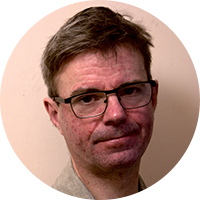In this new blog series, we hear directly from individual SIMULIA Champions about their own personal simulation story. This post from John Sawyer of Atkins Engineering is a continuation in the series, where he talks about how his love of horse riding is similar to problems he faces in his engineering career. John also tells us how much he enjoys being a SIMULIA Champion because of the sense of community and how it brings engineers together to solve problems.
Check out John’s presentation on structures simplification from the 2022 EuroNorth RUM. Also, don’t forget you can connect with all SIMULIA Champions in the SIMULIA Community!

Horses and Engineering?
Owning a horse is a lot like being an engineer. I’ve owned one since Easter of this past year and like engineering, there are always problems that arise that need solving. If the trailer for the horse breaks, I fix it; if the horse gets sick, I call the vet; if something hurts, I need to rethink how I’m riding. Of course, being an engineer has helped in my equestrian pursuits both as an owner and rider. You have to keep plugging away to solve more and more complex problems. For example, I’ve got a problem with my hips, so I’m constantly rethinking the biomechanics of my riding and how to get around the difficulties I face because my hips do not allow me to move in the way a person would normally ride. How do I keep rats out of the horse food? I build a better container to put the food in. So, I think about how I can solve the same problems but in different ways.
While cars and horses aren’t the same because we’re talking about a machine vs. a living creature, you can still apply engineering to understanding a horse and how you ride one. Horse riding has data that can be analysed in the same way as I would at work. I change something, look at the effects and evaluate the effectiveness. As an engineer I am very evidence-driven and I think this approach helps me in many ways.
A Family of Engineers
As a kid, I enjoyed computers and solving problems. I was always building stuff and making billy carts (soap box racers) and things that ran downhill. I grew up in Australia, so there’s a lot of space and good weather, so you could always do fun things. I also liked sports and other activities, but school was a good focus. Mathematics was always fun for me and I was very lucky as my father is an engineer and my mother was a mathematics teacher. So, as a basis for what I do, I could not have had better training. I always knew I would be an engineer once I realized I didn’t really want to be an astronomer. We are a family of engineers, in addition to my father, my brother is an engineer and he is married to one, and it always seemed like I was around engineering, fixing things, and solving problems. I looked at a few other careers, but engineering is what I like doing and what I am good at doing.
The Face of Abaqus in Australia
I started using Abaqus as part of my Ph.D. since my industrial sponsor used it. What was always a great thing about Abaqus, even as far back as the early 1990s, was you could implement your own subroutines in FORTRAN and so, if necessary, just implement your own novel material model which is what I did in my PhD. After I finished my Ph.D., Abaqus needed a new representative in Australia, and even though it’s not a big market, it’s enough to keep someone very busy. I was the support person, the training person, and the general sales person for Abaqus in Australia for a couple of years. I was working on everything, from mining equipment to automotive, defense and other manufacturing. Since arriving in the UK in the early 2000s, I have also been involved in the aerospace and nuclear industries, doing a lot of impact work and fracture mechanics. I did a lot of the heavy landing analysis work for the A350. Every time I see an A380, I look at the wingtip and say, well, I helped certify that with an Abaqus model!
SIMULIA Champion
Being a SIMULIA Champion is great because it’s a community of like-minded people and I enjoy seeing what other people are doing as well as helping others to use the software. For me, thinking of ideas to help solve problems is really interesting. I encourage anyone who wants to help, to join the Community and get involved. I believe that by helping others we learn more about solving problems for ourselves and thus become better engineers. The most important lesson I have learned while training people to use Abaqus is that you learn far more from explaining something to someone than you do by simply doing it yourself. If I have to explain an answer to someone else and justify why this is the right way, that is what really triggers gaining knowledge and understanding for me. You know the saying, to truly understand something, you have to teach it to someone else. And I think that’s the key benefit of being a part of the SIMULIA Champions Program.

Interested in the latest in simulation? Looking for advice and best practices? Want to discuss simulation with fellow users and Dassault Systèmes experts? The SIMULIA Community is the place to find the latest resources for SIMULIA software and to collaborate with other users. The key that unlocks the door of innovative thinking and knowledge building, the SIMULIA Community provides you with the tools you need to expand your knowledge, whenever and wherever.

